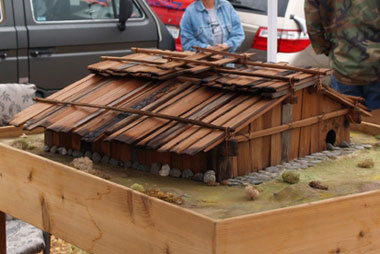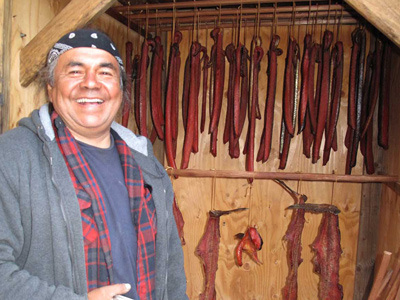Blue Creek Ah-Pah Traditional Yurok Village
Yurok arts and culture
The idea for Blue Creek-Ah Pah Traditional Yurok Village began several years ago when Willard Carlson Jr. was in the Friendship House rehabilitation program in San Francisco. Willard was near the end of the program and thinking about what to do next. He looked up and saw a street sign printed with the words, “Willard North” — this was a sign.
Willard knew then that he must return to his aboriginal home on the Klamath River. While traveling home and subsequently, he talked with his son, Per-gish, about starting a fishing and cultural tour service. This became Blue Creek Guide Service and is currently operated by Per-gish and Victoria Carlson. David Tripp of Hoopa/Yurok Vocational Rehabilitation Services helped set up this venture.
Later, Willard spoke with his late uncle Charlie Frye. Charlie told Willard that he must do everything he can to protect the land and the sacred High Country of the Yurok, Karuk and Tolowa peoples, where medicine people train to be doctors. They spoke of building a ceremonial Brush Dance pit at Ah Pah.
Later yet, Willard met his cousin David Frye. Over several visits to the river, they talked about what uncle Charlie had said and Willard told David about his plans to build a traditional Yurok village at Ah Pah. The village would include redwood plank houses, a Brush Dance pit, sweat house, dressing rooms for participants, dining facilities, and bathroom and shower facilities.
The village would focus upon rehabilitating the land, forests, river, salmon, ecosystems, habitat, culture, traditional and spiritual values, and the people. Not only Yuroks, but other people as well, would come and renew their cultural and spiritual roots. The village will eventually be self-sustaining. The project began small and very quietly.
The village would become a center for exploring various ways, both traditional and modern, to become self-sufficient and sustainable in such ways that are guided by, as well as enhance, the traditions and spirituality that are at the center of the Yurok lifeways. Once built, it would become a model for others to follow, building more villages upriver and downriver.
Willard and his mother, Marguerite, had already lived on family land near the village site for many years, and, in fact, are widely known on the River as Keepers of the site. They called a meeting of family, friends and interested persons to talk about rebuilding a village. On a cold, rainy, Saturday morning in March 2007, sixty or seventy people, young and old, Indian and White, gathered on a small flat above the overgrown village site and ate a feast of Klamath River salmon and eels cooked above an alder fire. They then said prayers and sang songs of thanks to the spirits of the river and forest, dedicating their future efforts to idea of Coming Home, of building a place where anyone, not just Yuroks, could come and be spiritually and physically renewed and made healthy again through prayer, meditation, education, and an indigenous ethic of community, hard work, and holistic thinking.
During the summer and fall of 2007, volunteers worked clearing the area; some contributed equipment or brought clothing and shoes; some cooked food; elders offered prayers and support. Once cleared, the land was excavated and re-seeded with native grasses and vegetation to protect the hills through the rainy winters.
During 2008 a secure tool shed and workshop was built. Water was brought to this structure to provide hot showers and toilet facilities for volunteer workers. A new septic system has been installed as well. Also during 2008, a large garden was planted. The garden will provide food for people living and working on-site as well as enough to sell to off-site buyers.
During 2008 the Brush Dance pit was excavated and construction began. A great deal of Old Growth Redwood was donated. With the help of volunteers and students from the Klamath Early College of the Redwoods School, the Redwood was milled and split for the Brush Dance pit. Nearly all of the material has been prepared and completion of the pit itself will be completed by 2010.
Once the Brush Dance pit is completed, the surrounding area will be prepared with pathways, parking areas, and benches. Dressing rooms and campsites will also be prepared for each of the tribes that participate in the Brush Dance. The first Brush Dance at the Blue Creek-Ah Pah Traditional Yurok Village will take place during the summer of 2010.
In 2012, 2010 and 2008, the Blue Creek Ah-Pah Traditional Yurok Village received a grant from ACTA’s Living Cultures Grants Program.



